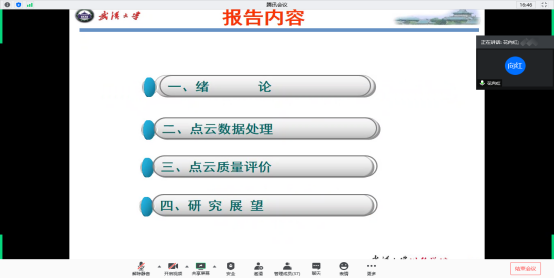On June 15, 2020, invited by Surveying and Mapping Engineering Institute, Prof. Xianghong Hua from Wuhan University, Prof. Yaolong Zhao from South China Normal University, Ph.D. candidate Pan Yu from Chongqing University and Senior Engineer Guang Wu from Chongqing Cultural Heritage Research brought four wonderful online academic reports for teachers and students of our school and other universities. The reports were held via the Tencent Meeting App. The topics of these reports were: “Research on 3DLaser Point Cloud Data Processing and Quality Evaluation Technology”, “Surveying, Geographic Information and Historical Culture”, “Models of Joints and Analysis of Seismic Performance of Traditional Wooden Structures” and “Application of 3D Laser Scanning Technology in the protection of cultural relics”. Associate Professor Ronghua Yang presided over these reports.
First, starting with the technical characteristics and workflow of 3D laser scanning, Professor Xianghong Hua introduced the characteristics, processing, quality evaluation of terrestrial laser scanning point cloud data and the product quality evaluation. sources of point cloud error, self-calibration model, point cloud error model, point cloud deformation monitorability index, point cloud registration quality evaluation, point cloud simplified quality evaluation and point cloud product quality evaluation were presented. At last, he summarized some problems that need further research in the field of point cloud data processing.

Next, starting with the development of surveying and mapping, the tools of surveying and mapping and industry concepts, Professor Yaolong Zhao introduced the process of geographic information from system to science, the definition and positioning of historical GIS, the current status and development trend of historical GIS research. Then he shared the historical GIS research case of Tibetan Buddhism and explained in detail how to determine the type of research data, explore the spatial distribution characteristics and explore the spatial and temporal evolution and cultural diffusion, how to quantify the impact of different factors on the development of religion, and how to build a historical and geographical process model.

Then, Pan Yu, a Ph.D. candidate of School of Civil Engineering of CQU, introduced the importance and necessity of the mechanical analysis of the connections and wooden frames of traditional buildings. Next, focusing on the mortise-tenon (MT) connections as an example, the friction-slip-contact of the three degrees of freedom of the MT connection was explained. And the coupling relationship between the three degrees of freedom is illustrated, which has a significant impact on the connections. Also, he introduced the Model Library formed by many key models of joints of ancient wooden structures and their significance value. Moreover, the seismic mechanism of Chinese ancient wooden structures is analysed from the perspective of force analysis and energy consumption analysis.

Finally, from the importance of the digitalization of cultural heritage, Deputy Director Guang Wu introduced the specific process of informatization of Cliff Carvings (Dafo Temple) in Danzishi, Nan'an District, including field data collection, point cloud registration, 2D line drawing production, etc. He then explained the advantages and disadvantages of 3D laser scanning technology in cultural relics information, the application of cultural relics informatization in the protection of ground cultural relics, and shared the utilization of 3D laser scanning technology in the protection of ground cultural relics, restoration and protection of public relics, and public propaganda and exhibitions. At the same time, Deputy Director Guang Wu also introduced the application of virtual display and experience technology in the integration of cultural relics and tourism by combining cases, and shared his personal thoughts on the digitalization of cultural heritage.

This academic report gave teachers and students who participated in the report a deeper understanding of the digital technology of cultural heritage, historical GIS technology, seismic mechanism of wooden structures in ancient buildings, virtual display and experience technology. Everyone benefited greatly.